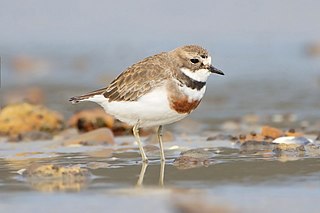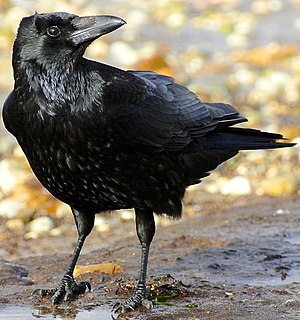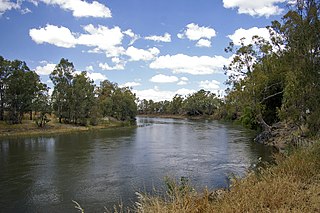
The brolga, formerly known as the native companion, is a bird in the crane family. It has also been given the name Australian crane, a term coined in 1865 by well-known ornithological artist John Gould in his Birds of Australia.

The snow goose, consisting of both a white morph and dark morph, is a North American species of goose commonly collectively referred to as "light geese". Its name derives from the typically white plumage. Many taxonomic authorities placed this species and the other "white geese" in the genus Chen. Most authorities now follow the traditional treatment of placing these species in the "gray goose" genus Anser. The scientific name is from the Latin anser, "goose", and caerulescens, "bluish", derived from caeruleus , "dark blue".

The little raven is a species of the family Corvidae that is native to southeastern Australia. An adult individual is about 48–50 cm (19–19.5 in) in length, with completely black plumage, beak, and legs; as with all Australian species of Corvus, the black feathers have a grey base, and the iris of the adult bird is white . Although the little raven was first named by Gregory Mathews in 1912, it was only in 1967 that there was consensus to separate it from the Australian raven as a distinct species.

The American white pelican is a large aquatic soaring bird from the order Pelecaniformes. It breeds in interior North America, moving south and to the coasts, as far as Central America and South America, in winter.

The brown pelican is a North American bird of the pelican family, Pelecanidae. It is one of three pelican species found in the Americas and one of two that feed by diving in water. It is found on the Atlantic Coast from Nova Scotia to the mouth of the Amazon River, and along the Pacific Coast from British Columbia to northern Chile, including the Galapagos Islands. The nominate subspecies in its breeding plumage has a white head with a yellowish wash on the crown. The nape and neck are dark maroon–brown. The upper sides of the neck have white lines along the base of the gular pouch, and the lower fore neck has a pale yellowish patch. The male and female are similar, but the female is slightly smaller. The nonbreeding adult has a white head and neck. The pink skin around the eyes becomes dull and gray in the nonbreeding season. It lacks any red hue, and the pouch is strongly olivaceous ochre-tinged and the legs are olivaceous gray to blackish-gray.

The Australian pelican is a large waterbird in the family Pelecanidae, widespread on the inland and coastal waters of Australia and New Guinea, also in Fiji, parts of Indonesia and as a vagrant in New Zealand. It is a predominantly white bird with black wings and a pink bill. It has been recorded as having the longest bill of any living bird. It mainly eats fish, but will also consume birds and scavenges for scraps if the opportunity arrises.

The blue-winged teal is a species of bird in the duck, goose, and swan family Anatidae. One of the smaller members of the dabbling duck group, it occurs in North America, where it breeds from southern Alaska to Nova Scotia, and south to northern Texas. It winters along the Pacific and Atlantic coasts and south into the Caribbean islands and Central America.

The Dalmatian pelican is the most massive member of the pelican family, and perhaps the world's largest freshwater bird, although rivaled in weight and length by the largest swans. They are elegant soaring birds, with wingspans that rival that of the great albatrosses, and their flocks fly in graceful synchrony. It is a short to medium distance migrant between breeding and overwintering areas. No subspecies are known to exist over its wide range, but based on size differences, a Pleistocene paleosubspecies, P. c. palaeocrispus, has been described from fossils recovered at Binagady, Azerbaijan.

The sittellas are a family, Neosittidae, of small passerine birds found only in Australasia. They resemble nuthatches, but whilst they were considered to be in that family for many years they are now afforded their own family. They do not migrate other than for local movements.

The spot-billed pelican or grey pelican is a member of the pelican family. It breeds in southern Asia from southern Pakistan across India east to Indonesia. It is a bird of large inland and coastal waters, especially large lakes. At a distance they are difficult to differentiate from other pelicans in the region although it is smaller but at close range the spots on the upper mandible, the lack of bright colours and the greyer plumage are distinctive. In some areas these birds nest in large colonies close to human habitations.

The trumpeter swan is a species of swan found in North America. The heaviest living bird native to North America, it is also the largest extant species of waterfowl with a wingspan that may exceed 10 ft (3.0 m). It is the American counterpart and a close relative of the whooper swan of Eurasia, and even has been considered the same species by some authorities. By 1933, fewer than 70 wild trumpeters were known to exist, and extinction seemed imminent, until aerial surveys discovered a Pacific population of several thousand trumpeters around Alaska's Copper River. Careful reintroductions by wildlife agencies and the Trumpeter Swan Society gradually restored the North American wild population to over 46,000 birds by 2010.

The welcome swallow is a small passerine bird in the swallow family.

The Heermann's gull is a gull resident in the United States, Mexico and extreme southwestern British Columbia, nearly all nesting on Isla Rasa in the Gulf of California. They are usually found near shores or well out to sea, very rarely inland. The species is named after Adolphus Lewis Heermann, nineteenth-century explorer and naturalist.

The double-banded plover, known as the banded dotterel or pohowera in New Zealand, is a species of bird in the plover family. Two subspecies are recognised: the nominate Charadrius bicinctus bicinctus breeds throughout New Zealand, including the Chatham Islands, while Charadrius bicinctus exilis breeds in the Auckland Islands.

The New Zealand fairy tern or tara-iti is New Zealand's rarest breeding bird. A subspecies of the fairy tern, it is the smallest tern that breeds in New Zealand, and nests in just four locations between Whangarei and Auckland in the North Island. It is critically endangered and at risk of extinction, with less than 40 remaining individuals and only 5 breeding pairs. Its main threats are introduced predators, extreme storms and tides, beach activity, and waterfront development.

The buff-breasted paradise kingfisher is a bird in the tree kingfisher subfamily, Halcyoninae. It is native to Australia and New Guinea. It migrates in November from New Guinea to its breeding grounds in the rainforest of North Queensland, Australia. Like all paradise kingfishers, this bird has colourful plumage with a red bill, buff breast and distinctive long tail streamers.

The striped honeyeater is a passerine bird of the honeyeater family, Meliphagidae, found in Australia. It is a medium-sized honeyeater, about 23 centimetres (9.1 in) in length. Both sexes are a light greyish brown with dark brown centres to the feathers, which give the appearance of stripes. The stripes are particularly distinct on the head and back of the neck. While it is found mainly in inland eastern Australia where it inhabits the drier open forests, it is also found in coastal swamp forests from south east Queensland to the central coast of New South Wales.

The Indian skimmer or Indian scissors-bill is one of the three species that belong to the skimmer genus Rynchops in the family Laridae. They are somewhat tern-like but like other skimmers, have a short upper mandible and the longer lower mandible that is ploughed along the surface of water as the bird flies over the water to pick aquatic prey. It is found in southern Asia, where it is patchily distributed and declining in numbers. They are mainly found in rivers or estuaries. They are very brightly marked in black, white and orange, making them difficult to miss.

The pinyon jay, historically known as the blue crow or Maximilian's jay, is a jay between the North American blue jay and the Eurasian jay in size. It is the only member of the genus Gymnorhinus, (monotypic). Its overall proportions are very nutcracker-like and indeed this can be seen as convergent evolution as both birds fill similar ecological niches. The pinyon jay is a bluish-grey coloured bird with deeper head colouring and whitish throat with black bill, legs and feet.

The sarus crane is a large non-migratory crane found in parts of the Indian Subcontinent, Southeast Asia and Australia. The tallest of the flying birds, standing at a height of up to 1.8 m, they are a conspicuous species of open wetlands in south Asia, seasonally-flooded Dipterocarp forests in south-east Asia, and Eucalyptus-dominated woodlands and grasslands in Australia.






























